Blog & Latest Updates
Fly Fishing Articles
Insects by Common Name


Insect Order Plecoptera (Stoneflies)
Taxonomic Navigation -?-
Kingdom
Animalia (Animals)
» Phylum
Arthropoda (Arthropods)
» Class
Insecta (Insects)
» Order Plecoptera (Stoneflies)
1 family isn't included.
Common Name
| Match | Common Name |
| Stoneflies |
The year begins with the little dark stoneflies of the Capniidae, Leuctridae, and Nemouridae families as some of the only active aquatic insects available to trout. As the year progresses into late Winter and early Spring, the Large Springflies of the Perlodidae family in the West and Willowflies of the Taeniopterygidae are sometimes the first dry-fly insects of the season. When Spring fully arrives, so do the most significant stoneflies for the angler - the gigantic Pteronarcyidae Salmonflies of western legend. The large Golden Stones of the Perlidae supplement these hatches and are more common across the country. Summer brings on significant hatches of the Little Yellow Stones of the Perlodidae family and the little yellow or green Chloroperlidae flies that are common sights.
Hatching Behavior
While there is some evidence to suggest that a few species in the West may emerge in open water, stoneflies largely owe their lesser status to a terrestrial (Terrestrial: Insects which live on land and are fed on by trout only when they incidentally fall into the water are known as "terrestrials" to fly anglers, and they're very important in late summer.) emergence style. This keeps them safe from trout at a stage when most mayflies and caddisflies are highly vulnerable. With few exceptions, they emerge by crawling out of the water onto rocks, sticks, or other shoreline objects. In some species the adult emerges from the nymph within inches of the water; others crawl quite a distance back into the woods. But this distinction matters little to the trout. In the East, populations of the larger species are sparser and their activity is most often nocturnal. This further reduces their importance to anglers, if not the trout.
After emerging, the adults may live for up to a month. Like caddisflies and unlike mayflies, many stonefly species can eat and drink as adults.
Egg-Laying Behavior
Stonefly adults are usually most important when laying their eggs after mating; particularly the larger species. Some drop their eggs from above the water but many either flutter along the surface or land on the water and create a commotion capable of drawing savage strikes from large trout during midday. This behavior together with the broken surface of the water are reasons for the historic success of bushy, hair winged Sofa Pillow/Stimulator styles of dry flies.
Stoneflies often fall spent (Spent: The wing position of many aquatic insects when they fall on the water after mating. The wings of both sides lay flat on the water. The word may be used to describe insects with their wings in that position, as well as the position itself.) after ovipositing and can gather in eddies or slack water in surprising numbers. Anglers will do well to to look for this, particularly early on Summer mornings. Be prepared with less bushy and flush floating flies to take advantage.
Juvenile Biology
Stonefly nymphs are adept "clinger/crawlers." They have double claws on their tarsi (
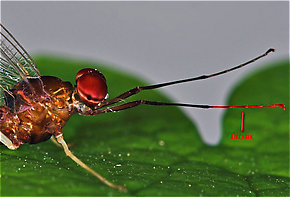
The tarsus of this Isonychia bicolor mayfly spinner is highlighted in red.
When the emergence of an especially abundant species is near, its nymphs may be so active and concentrated that trout feed on them selectively near the emergence sites. This is more common in the West where the cool, swift rivers draining its mountains hold remarkable stonefly populations.
Pictures of 151 Stonefly Specimens:
Pteronarcys biloba (Knobbed Salmonfly) Stonefly Nymph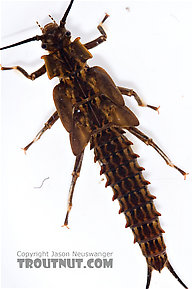 View 17 Pictures
View 17 Pictures
 View 17 Pictures
View 17 PicturesCollected May 6, 2007 from the Neversink River (above reservoir) in New York
Added to Troutnut.com by Troutnut on May 10, 2007
Added to Troutnut.com by Troutnut on May 10, 2007
Female Acroneuria lycorias (Golden Stone) Stonefly Adult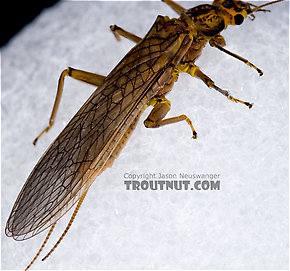 View 17 Pictures
View 17 Pictures
 View 17 Pictures
View 17 PicturesCollected May 23, 2007 from Aquarium (collected somewhere in Catskills) in New York
Added to Troutnut.com by Troutnut on June 4, 2007
Added to Troutnut.com by Troutnut on June 4, 2007
Isogenoides hansoni (Appalachian Springfly) Stonefly Nymph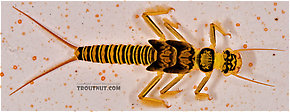 View 11 PicturesThis large Perlodidae stonefly was a strikingly bright yellow color, more so than any other insect I've seen. I didn't enhance it much. See the discussion threads to follow how we identified this specimen, which was listed incorrectly for several years.
View 11 PicturesThis large Perlodidae stonefly was a strikingly bright yellow color, more so than any other insect I've seen. I didn't enhance it much. See the discussion threads to follow how we identified this specimen, which was listed incorrectly for several years.
 View 11 PicturesThis large Perlodidae stonefly was a strikingly bright yellow color, more so than any other insect I've seen. I didn't enhance it much. See the discussion threads to follow how we identified this specimen, which was listed incorrectly for several years.
View 11 PicturesThis large Perlodidae stonefly was a strikingly bright yellow color, more so than any other insect I've seen. I didn't enhance it much. See the discussion threads to follow how we identified this specimen, which was listed incorrectly for several years.Collected April 19, 2006 from Mongaup Creek in New York
Added to Troutnut.com by Troutnut on April 21, 2006
Added to Troutnut.com by Troutnut on April 21, 2006
6 Underwater Pictures of Stoneflies:
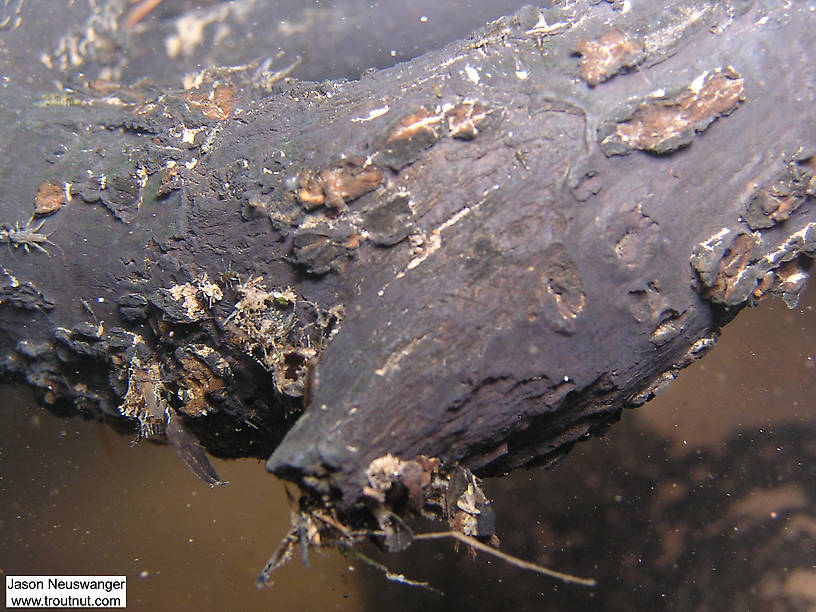
There are several mayfly and stonefly nymphs clinging to this log.
In this picture: Mayfly Family Baetidae (Blue-Winged Olives) and Stonefly Family Taeniopterygidae (Willowflies).
In this picture: Mayfly Family Baetidae (Blue-Winged Olives) and Stonefly Family Taeniopterygidae (Willowflies).
StateWisconsin
LocationEighteenmile Creek
Date TakenMar 19, 2004
Date AddedJan 25, 2006
AuthorTroutnut
CameraOlympus C740UZ
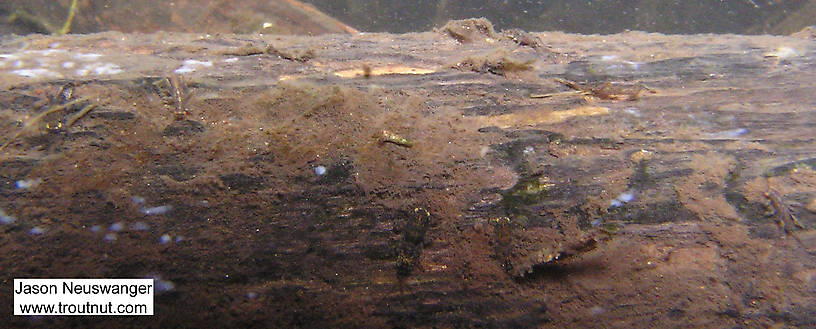
The mayfly and stonefly nymphs in this picture blend in extremely well.
In this picture: Mayfly Species Ephemerella invaria (Sulphur Dun) and Insect Order Plecoptera (Stoneflies).
In this picture: Mayfly Species Ephemerella invaria (Sulphur Dun) and Insect Order Plecoptera (Stoneflies).
StateWisconsin
LocationNamekagon River
Date TakenMar 20, 2004
Date AddedJan 25, 2006
AuthorTroutnut
CameraOlympus C740UZ
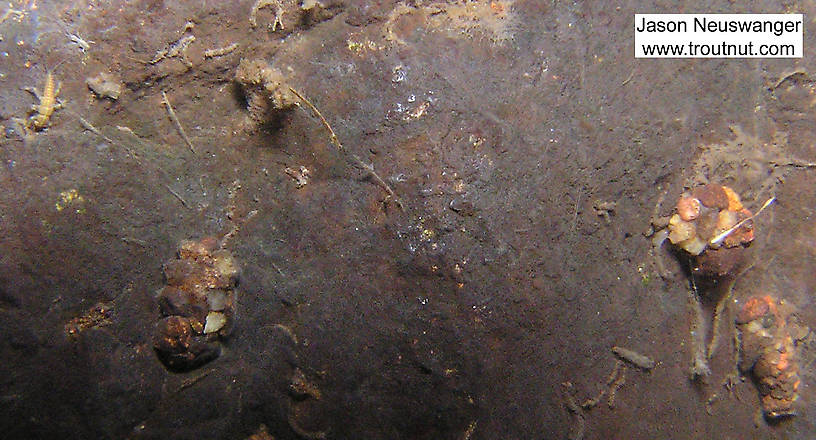
In this picture: Insect Order Trichoptera (Caddisflies), Insect Order Plecoptera (Stoneflies), and Insect Order Ephemeroptera (Mayflies).
StateWisconsin
LocationNamekagon River
Date TakenMar 20, 2004
Date AddedJan 25, 2006
AuthorTroutnut
CameraOlympus C740UZ
Recent Discussions of Plecoptera
Little Black Stonefly pics 12 Replies »
Posted by Adirman on Apr 14, 2018 in the species Allocapnia granulata
Last reply on Apr 21, 2018 by Martinlf
Hey guys, went out on the Neversink for awhile today and had a look around, saw a lot of little dark flies, may be the little black stone fly? Hard to tell cuz looked like Caddis too. Looks like about a size 16? Any pics of available of this species would be great.
Thanks
ReplyHigh Water 8 Replies »Thanks
Posted by Dbar on Apr 13, 2007 in the species Pteronarcys californica
Last reply on Jun 11, 2017 by Ricofreako
The hatch often occurs during high water (just after peak) so you sometimes have limited visibility during the hatch. Also - I believe that they can occur above 7000 feet.
Love ths site.
ReplySalmonfly question for you westerners 7 Replies »Love ths site.
Posted by Troutnut on Jul 30, 2006 in the species Pteronarcys californica
Last reply on Jun 4, 2016 by Chipper
I don't have many reliable sources about this species, so it'd be great if you western fishermen could read over the article and make sure I haven't said anything stupid or omitted anything important. I'll be happy to incorporate any additions you have.
ReplyHelopicus subvarians (Stonefly) common in New York waters! 6 Replies »I have observed the Helopicus subvarians (springtime stonefly) for over 30 years on many of New Yorks Rivers, such as Beaverkill/Willowwemoc, Ausable (both east and west branch), West Canada Creek, and several others. Most of this time I believed it to be Acroneura nigrita ( Black Willow Stonely) as described by Ernest Schwiebert (Nymphs). Very distinct about the coloring of this Staonely is the last (rearward) sternites are very yellow (Ausable almost orange) while the riest is mostly black top and bottom. The thorax is again very distinctly marked with yellow (orange) with black on top. It is a most beautiflul stonefly, and is see it in May and June. It is well represented by the Montana Nymph is Black with yellow.
Replylittle green stonefly 4 Replies »I was just at my local river and the fish were pounding the surface. I was able to identify the fly on the water as a little green stonefly and am very interested in some good patterns to tie to imitate it. Any and all suggestions would be appreciated.
ReplyThere are 9 more topics.
Your Thoughts On Plecoptera:
Top 10 Fly Hatches
Top Gift Shop Designs
Eat mayflies.
Top Insect Specimens
Miscellaneous Sites
Troutnut.com is copyright © 2004-2024 Jason
Neuswanger (email Jason). See my FAQ for information about use of my images.
 privacy policy
privacy policy
